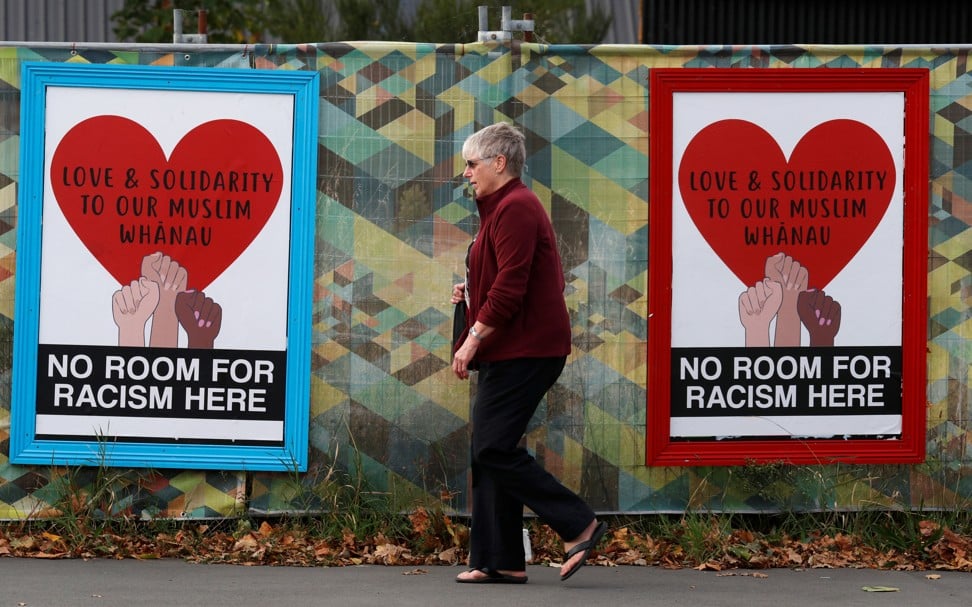
Was the Christchurch shooter part of a white-supremacist network taking cues from al-Qaeda and Islamic State?
- Links have emerged between the shooter and a Ukrainian ultranationalist, white supremacist paramilitary organisation called the Azov Battalion
- Ironically, there are similarities in ideology, strategy and recruitment tactics between such right-wing extremists and jihadist groups
His transnational ties go beyond Ukraine, however, as he claimed he was in touch with Anders Behring Breivik, the Norwegian terrorist, and he took trips throughout Europe, including the Balkans, visiting sites that symbolised historical battles between Christians and Muslims.
In the video of his attack, he was heard listening to a song that glorified Bosnian-Serb war criminal Radovan Karadzic, and his gun bore racist messages and the names of white supremacists from around the world.
The Azov Battalion is emerging as a critical node in the transnational right-wing violent extremist (RWE) network. This group maintains its own “Western Outreach Office” to help recruit and attract foreign fighters that travel to train and connect with people from like-minded violent organisations from across the globe.
Operatives from the outreach office travel around Europe to promote the organisation and proselytise its mission of white supremacy. In July 2018, German-language fliers were distributed among the visitors at a right-wing rock festival in the German state of Thuringia, inviting them to be part of the Azov battalion: “join the ranks of the best” to “save Europe from extinction”.
It has also established youth camps, sporting recreation centres, lecture halls, and far-right education programmes, including some that teach military tactics and far-right ideology to children as young as nine years old. This aggressive approach to networking serves one of the Azov Battalion’s overarching objectives – transforming areas under its control in Ukraine into the primary hub for transnational white supremacy.
Too often, the focus on foreign fighters has been relegated to Sunni jihadists, but in a globalised world, the foreign fighter phenomenon has deep roots across ideologies, from foreign fighters assisting the Kurds in Iraq and Syria, to Shi’a militants travelling from Afghanistan, Pakistan, Iraq, and Lebanon to join with Iranian-backed foreign fighter networks operating in Syria.
It is now evident that RWE networks are also highly active in recruiting fighters from around the world to their cause, with the Azov Battalion and other ultranationalist organisations playing a significant role in the globalisation of RWE violence.
Indeed, the Azov Battalion is forging links with RWE groups, hosting visits from ultranationalist organisations such as members of the Rise Above Movement (RAM) from the United States and National Action from Britain, among other white supremacists from around the world.
In the US, several RAM members (all American citizens) who spent time in Ukraine training with the Azov Battalion were recently indicted by the US Federal Bureau of Investigation for their role in violently attacking counterprotesters during the August 2017 “Unite the Right” rally in Charlottesville, Virginia.
Ironically, there are similarities in ideology, strategy and recruitment tactics between Salafi-Jihadist organisations – such as al-Qaeda and the so-called Islamic State – and RWE groups. Both types of violent groups seek to implement their own versions of what they consider to be a “pure” society.
There are striking resemblances between al-Qaeda’s Maktab al-Khidamat and the Azov Battalion’s “Western Outreach Office”, both of which had the responsibility for promoting the cause and helping recruits reach the battlefield. Just as Afghanistan served as a sanctuary for jihadist organisations like Egyptian Islamic Jihad and the Libyan Islamic Fighting Group in the 1980s, so too are parts of Ukraine becoming a safe haven for an array of violent RWE groups to congregate, train, and radicalise.
And just like the path of jihadist groups, the goal of many of these members is to return to their countries of origin (or third-party countries) to wreak havoc and use acts of violence as a means to recruit new members to their cause. Unlike jihadis who are attempting to strike Western targets, however, radicalised white supremacists have the added advantage of being able to blend in seamlessly in the West, just as the Christchurch shooter was able to do.
He was not simply a lone actor, but the product of a broader network of violent right-wing extremists. If the evidence ultimately proves that the shooter went to Ukraine to train with like-minded individuals, then the attack in New Zealand was possibly the first example of an act of terrorism committed by a white supremacist foreign fighter. And unless the international community recognises the danger posed by these transnational networks, the New Zealand attack is unlikely to be the last.

